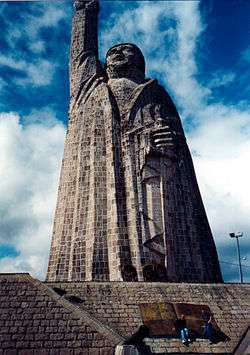Janitzio
Isla de Janitzio is the main island of Lake Pátzcuaro in the state of Michoacán, Mexico.[1]
Janitzio | |
|---|---|
Island | |
| Isla de Janitzio | |
 Statue of José María Morelos at Janitzio | |
| Country | |
| State | Michoacán |
| Time zone | UTC-6 (CST) |
The town of Janitzio, which means "where it rains", is located atop the hill. Janitzio can only be reached by boats which run regularly back and forth from about 7:30 am to 6 pm, accessible from Pátzcuaro's pier (embarcadero). It is the largest of five islands in Lake Pátczuaro.[2]These boats can be hired to take visitors around other parts of the lake. The boats are pretty regular and takes approximately 25 minutes to reach the island.[3]The town is known for the butterfly fishermen who are skilled at lowering their butterfly-shaped nets to catch the local cuisine "pescado blanco". The butterfly fisherman were also located on the back of the 50 peso Mexican banknote.
The island is the subject of Silvestre Revueltas's 1933 composition Janitzio.
Statue of José Maria Morelos
A 40-meter statue of José María Morelos, a great hero of Mexico's independence, started in 1933, is found on the island's highest point. You can see the statue of Morelos from the boat, when arriving.[4]Visitors can climb to the top of the statue by way of a staircase that spirals up the inside. Along the interior walls, the life of Morelos is depicted in murals painted by Ramón Alba de la Canal and other Mexican muralists. At the top, visitors can look through peepholes in the giant raised fist of Morelos, with views of the island, lake and surroundings.
People
Some of the people of Janitzio and the towns surrounding Lake Pátzcuaro are of indigenous descent and are known as Purépecha. Available in Janitzio are regional handicrafts. A variety of handmade textiles and artwork are sold.
Its main festivity is "El Día de los Muertos" or Day of the Dead. As part of this festivity, candle-lit boat processions make their way to the island and then to Janitzio's Church and graveyard, remaining there for the night for a large festive vigil with much imbibing involved.
Climate
Mild, spring-like temperatures prevail most of the year in the North Central Highlands of central Mexico. The highlands have a climate that is described as a "mild, dry climate." The area around Janitzio rarely sees temperatures that go above 80 degrees, even in summer. Daytime temperatures remain fairly consistent year round, however, it can become quite cold at night from November through March. The rainy season runs from May through October, with July and August generally being the wettest months. Quick moving thunderstorms can be expected over the summer months, June to September. The rest of the year remains quite dry.
Gallery
References
- Brandes, S. (2009). Skulls to the Living, Bread to the Dead: The Day of the Dead in Mexico and Beyond. Wiley. p. 77. ISBN 978-1-4051-7870-9. Retrieved 22 June 2018.
Janitzio, a small picturesque island on Lake Pátzcuaro, where the Tarascan inhabitants had become famous for essentially the same practices as were being carried out in Tzintzuntzan at the time. Foster and Ospina in 1948 declared that All ...
- "Tourism: The Legacy of Conquest in Michoacán". Chicano & Latino Studies | College of Liberal Arts. 2019-04-29. Retrieved 2020-06-03.
- Woodman, Stephen. "A Guide to the Island of Janitzio: Mexico's Butterfly Island". Culture Trip. Retrieved 2020-06-03.
- "janitzio". www.uvm.edu. Retrieved 2020-06-03.
External links
![]()

